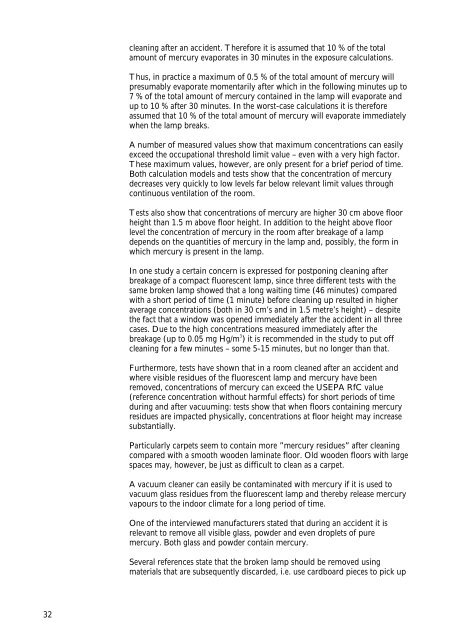No. 104 - Miljøstyrelsen
No. 104 - Miljøstyrelsen
No. 104 - Miljøstyrelsen
You also want an ePaper? Increase the reach of your titles
YUMPU automatically turns print PDFs into web optimized ePapers that Google loves.
32<br />
cleaning after an accident. Therefore it is assumed that 10 % of the total<br />
amount of mercury evaporates in 30 minutes in the exposure calculations.<br />
Thus, in practice a maximum of 0.5 % of the total amount of mercury will<br />
presumably evaporate momentarily after which in the following minutes up to<br />
7 % of the total amount of mercury contained in the lamp will evaporate and<br />
up to 10 % after 30 minutes. In the worst-case calculations it is therefore<br />
assumed that 10 % of the total amount of mercury will evaporate immediately<br />
when the lamp breaks.<br />
A number of measured values show that maximum concentrations can easily<br />
exceed the occupational threshold limit value – even with a very high factor.<br />
These maximum values, however, are only present for a brief period of time.<br />
Both calculation models and tests show that the concentration of mercury<br />
decreases very quickly to low levels far below relevant limit values through<br />
continuous ventilation of the room.<br />
Tests also show that concentrations of mercury are higher 30 cm above floor<br />
height than 1.5 m above floor height. In addition to the height above floor<br />
level the concentration of mercury in the room after breakage of a lamp<br />
depends on the quantities of mercury in the lamp and, possibly, the form in<br />
which mercury is present in the lamp.<br />
In one study a certain concern is expressed for postponing cleaning after<br />
breakage of a compact fluorescent lamp, since three different tests with the<br />
same broken lamp showed that a long waiting time (46 minutes) compared<br />
with a short period of time (1 minute) before cleaning up resulted in higher<br />
average concentrations (both in 30 cm’s and in 1.5 metre’s height) – despite<br />
the fact that a window was opened immediately after the accident in all three<br />
cases. Due to the high concentrations measured immediately after the<br />
breakage (up to 0.05 mg Hg/m 3<br />
) it is recommended in the study to put off<br />
cleaning for a few minutes – some 5-15 minutes, but no longer than that.<br />
Furthermore, tests have shown that in a room cleaned after an accident and<br />
where visible residues of the fluorescent lamp and mercury have been<br />
removed, concentrations of mercury can exceed the USEPA RfC value<br />
(reference concentration without harmful effects) for short periods of time<br />
during and after vacuuming: tests show that when floors containing mercury<br />
residues are impacted physically, concentrations at floor height may increase<br />
substantially.<br />
Particularly carpets seem to contain more ”mercury residues” after cleaning<br />
compared with a smooth wooden laminate floor. Old wooden floors with large<br />
spaces may, however, be just as difficult to clean as a carpet.<br />
A vacuum cleaner can easily be contaminated with mercury if it is used to<br />
vacuum glass residues from the fluorescent lamp and thereby release mercury<br />
vapours to the indoor climate for a long period of time.<br />
One of the interviewed manufacturers stated that during an accident it is<br />
relevant to remove all visible glass, powder and even droplets of pure<br />
mercury. Both glass and powder contain mercury.<br />
Several references state that the broken lamp should be removed using<br />
materials that are subsequently discarded, i.e. use cardboard pieces to pick up

















